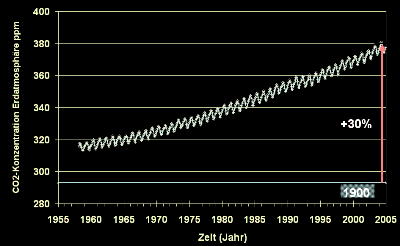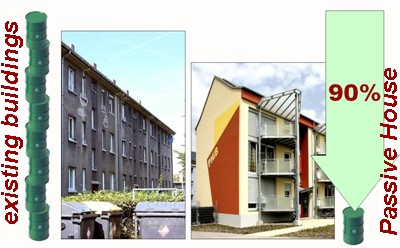Table of Contents
Greenhouse effect and climate protection
Everyone is now aware that the Earth is “suffering from fever” – this was the headline featured on the front page of a popular German newspaper on 5th November 2006. On 2nd February 2007 the IPCC (Intergovernmental Panel on Climate Change) published its new “Climate Change 2007” report. Slowly the realisation that it is now time to act, is sinking in.
The Passive House Institute has always refrained from painting pictures of doom and gloom. The scientific community has known about these interactions since the late 70s: Carbon was originally present as CO2 in the Earth's atmosphere in large quantities. Rainfall and vegetation has washed out and bound this CO2 in the course of billions of years, e.g. in the form of coal, crude oil and natural gas, leaving a remainder of less than 0.03% in the air. For the last two hundred years we have been using large quantities of this carbon as an energy carrier. The fuel containing carbon is burned, thereby producing CO2 again. And this CO2 is returned to where it once came from hundreds of millions of years ago i.e. the atmosphere.
It has long been known that this increase in CO2 concentration in the atmosphere leads to serious and undesirable changes in the world climate. Infernal surface temperatures of about 450°C prevail on our neighbouring planet Venus. For many years, responsibly-thinking and acting people like Professor Klaus Töpfer, who was a former Minister for the environment in Germany, have always pointed out that mankind, with its unchecked fuel consumption, is the cause of global warming. Serious scientific information is available on this topic for those who want to know more about it, predominantly from IPCC (Website), which has scientists from almost all countries of the world as members.
The Passive House Institute doesn't need to add anymore to the information already available about climate change. The effects of continuing and unchecked emission of greenhouse gases into the atmosphere can be tremendous and irreversible. Some of these effects are becoming more and more apparent today, for example, melting glaciers.
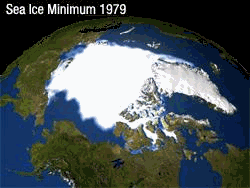 | The northern polar region (image by NASA): a thermometer. The enormous temperature increase over the past decades has caused vast parts of the polar ice to vanish. Glaciers are another long-term indicator for the increase in temperature: To learn more about this phenomenon, please read the following Wikipedia article: Retreat of glaciers since 1850. |
But this development is still preventable - at least in part. The worst consequences can be avoided by taking responsible action, right now.
The Passive House Institute has been working on concepts which can help to avert some of the worst consequences. That is the good news:
there are many possibilities for limiting the further emission of CO2 into the atmosphere.
And these possibilities do not necessitate the reliquishment of prosperity, economic growth and comfort. On the contrary:
they offer the chance to create a more sustainable, humane and future-oriented economy and to make life more pleasant.
Climate protection must begin today. More possibilities for practical measures will be shown here and on the the other pages of passipedia. Measures that are not just beautiful or radical-sounding words: This is about real construction, it is about action, about substantial measures. Substantial measures that contribute to climate protection, so that our children can inherit from us an Earth where life is worth living. Measures, which do not hurt - but open an opportunity for all people on the planet.
What are the reasons for the increased CO2 levels? Energy Consumption
Climate change is mainly caused by fossil energy consumption.
About 80 % of the worlwide energy consumption today(2020; 2008 it was still 85%) is covered by crude oil, natural gas and coal. These fuels are also known as “fossil energy sources”. They consist mainly of the elements carbon and hydrogen; when these fuels are burned, CO2 and water (H2O) are produced.
These combustion gases are mostly (over 99%) given off into the atmosphere. The water doesn't cause problems, however; it is the global CO2 content of the atmosphere which constantly keeps increasing, significantly and measurably (see the following illustration), due to the continued burning of fossil fuels. That the increase measured in the Atmosphere's CO2 contend (see the Graph following) is indeed mainly caused by the burning of fossil fuels was independently proven by measurements of the development of the Carbon (C)-isotopes in the air: See: antgropogenic CO2? - Fossil fuels do not contain a large amount of the 14C-isotope.
The CO2 in the atmosphere prevents the heat from the earth's surface from radiating into the (very cold) outer space, because CO2 reabsorbs the radiation in exactly those spectrum ranges where the atmosphere is transparent for thermal radiation.
CO2 therefore functions as an additional layer of insulation enclosing the earth : an insulation layer which is transparent for the entering sunlight. Solar radiation is the main energy supply to the earth's surface, that is why we speak of the greenhouse effect .
The effect of CO2 absorbing thermal radiation can be proven using equipment, which is available at any highschool physics laboratory. This is a short video, doing the experiment:
Iain Stewart: CO2 absorbs thermal radiation.
The most important principle in science is, that scientific questions can be scrutinised by everybody: You can just visit your nearest glacier and check whether and how fast it is retreating. There is not a big problem in demonstrating CO2 absorbing infrared readiation, you can ask anybody with a thermal camera to assist you in doing this experiment yourself. You can even start to measure the CO2-content of the atmosphere yourself - CO2 sensors are available now for reasonable prices, we use them for measuring and controlling the indoor air quality (well, be aware, you do have to calibrate these sensors, the sensors age, without calibration the results are poor). It is not so, that the question ends with “Whom do I trust? Which expert do I choose?”. So why is there this growing deception - with self declared “scientists” on every channel that proclaim that there is nothing to be concerned about and that the global warming process is nothing but a Hoax? It's easy: Check whose interests are involved and there the money comes from. Yes, it's a lot of money; yes, there are a lot of rich and powerful special interests affected. Here is another video giving some background information: science and distortion. It is interesting, that even in 2020, the distortion is still ongoing - and the price for change will rise the longer we wait.
Developed countries still consume the most energy
The worldwide energy demand is mostly covered by coal, oil and natural gas – and this consumption mostly takes place in the developed countries: about 75% of today's energy consumption is consumed by just 25% of the world's population living in the developed countries.
The causes of climate change being observed today, lie here and not in the developing nations. However, many of the countries with the highest populations in the world are catching up in terms of their energy consumption. For example, the energy consumption in China has increased greatly in the last few years. This was one reason for the great increase in the world market prices for crude oil. To a great extent, other countries follow the example of the industrialised countries for their development. Because here the use of energy is seen as being smart and a sign of great prosperity, the emerging developing countries also strive to have as much energy at their disposal as possible. By the way: The Passive House Institute has engaged in educating architects and engineers in China and in other fast developing countries to enable them to use the Passive House concept. Be aware, that this will not be really convincing as long as we, the people in the already wealthy countries, do not do the right thing ourselves!
How smart is the striving for high energy consumption?
In many old energy-management publications the per capita energy consumption of the population serves as the yardstick for measuring the development status of a country. This easily determined measure has also been used just as often by economists, geographers and sociologists, and this is how the wrong conclusion, that a high energy consumption is a measure of the prosperity and development of a country, has become fixed in the minds of politicians and a great part of the population.
The notion that “high energy consumption equals greater prosperity”, is completely false.
It turns the facts upside down: A higher specific energy consumption is not a sign of prosperity – it is first and foremost a sign of inefficiency . Above all, obsolete and inefficient buildings, vehicles, machines and tools consume high amounts of energy. Modern future-oriented technology uses energy much more efficiently.
Illustration 1: Inefficient economy
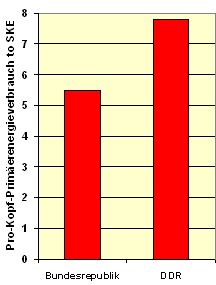 The primary energy consumption per person in the former GDR (East Germany; image: DDR) with an annual per capita energy consumption of 7.8 tons of coal equivalent (TCE) was about 40 % greater than that of the former West Germany (image: Bundesrepublik) (5.48 TCE).
The primary energy consumption per person in the former GDR (East Germany; image: DDR) with an annual per capita energy consumption of 7.8 tons of coal equivalent (TCE) was about 40 % greater than that of the former West Germany (image: Bundesrepublik) (5.48 TCE).
The comparison of economic power and prospertity in both these countries is well-known: the buildings, vehicles and machines in the former East Germany were much less efficient than those in West Germany. It isn't the quantity of the consumption but rather it is the quality of the usage which matters.
Embarassing: in some energy management text books this example has been misrepresented due to ignorance of the names of the countries: “The higher energy consumption results from the visibly greater prosperity of the GDR” (this author mistook the “democratic republic” for West Germany).
Illustration 2: Locomotives
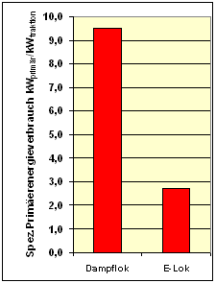 Railway companies didn't switch from steam engines (“Dampflok”) to electric locomotives without reason. Even the electrification of all the track system, which was an expensive investment, was worth it:
Railway companies didn't switch from steam engines (“Dampflok”) to electric locomotives without reason. Even the electrification of all the track system, which was an expensive investment, was worth it:
The best steam engines had an efficiency of around 10%. The primary energy efficiency of the electrical traction is around 30% and can still be increased quite considerably.
The power stations in operation today were built in times when energy sources were much cheaper and modern technologies like combined cycle plants hadn't yet been developed. An energetic recovery system for braking energy is rarely practiced today - and the weight of vehicles can be reduced even further.
The future energy system will have to be based on renewable sources mainly. Look at Germany as an example: The amount of electricity produced by renewable sources like wind power and photovoltaics has been growing significantly during the last decades. This also includes much improved efficieny. The “primary energy renewable” or PER, a measure introduced by the Passive Hosue Institute in 2014, counts the renewable primary source energy for a given final energy carrier. If used for electric traction (like a railway train), this PER-Factor is in the range of PERel,traff = 1.3; much better than the former fossil fuel factor for a coal fired power plant, which was in the range of 2.7.
Illustration 3: Passive House
Each year, old buildings in Europe use more than 16 litres of heating oil on average per square metre of living area for heating alone. That is about one third of the total energy consumption in Europe.
Passive Houses, like those examples already built all over Europe, reduce the energy demand for heating to less than one-tenth in comparison with the actual consumption (only 1.5 litres per square metre remaining). In doing so, the level of living comfort is improved even more. Older buildings can also be retrofitted with better insulation and heat recovery. In this way Europe can become more independent of energy imports - and at the same time employment opportunities can be created for innovative companies and trades. The improved insulation measures and ventilation technology required is cost-efficient at today's energy prices if assistance is available through low- interest loans from the KfW .
The list of examples could go on and on. In our information pages relating to "Energy efficiency" and "Performance" you can find many other examples and also basic considerations about how and why energy efficiency can be increased everywhere on a wide scale: contrary to popular opinion, the technical limits of improved energy utilisation have not even been touched .
Following a detailed analysis of the facts we come to a clear conclusion which will seem to be surprising for some economists and unheard of for most energy economists:
A high per capita energy consumption is a sign of inefficiency and backwardness, not prosperity.
This also applies to road transport. The efficiency of vehicles can be increased considerably without sacrificing comfort and speed. If we, as citicens in countries with the highest per capita consumption in the world, want to maintain and improve our prosperity and our economic strength in the future, we must above all do one thing:
Increasing energy efficiency
For example the European Commission has realised the need for increased energy efficiency very well. The fact that German interest groups are trying to slow down progress towards more energy efficiency just does not fit the image of the advanced German economy. Higher commitment is essential if we wish to keep pace with the world market in the future. “It is not the reduction of CO2 emission values which leads to the loss of jobs, the loss will happen if the necessary reduction is not instituted ” - here we have to agree with the EU Commissioner Dimas.
It is fitting that improvement of energy efficiency also causes a great reduction in CO2 emission into the atmosphere. A strategy that works well for our future prosperity and advanced economic development is also good for preserving the living conditions on our planet. However, this development towards considerably improved efficiency must partly be accomplished in the face of resistance from rich and powerful special interest groups.
The Energy Benefit
Some 25 years ago, the term “energy service” was coined by Prof. Hartmut Bossel to describe the objectives of energy application. Unfortunately, this term quickly came to be used in another sense by completely different service providers, and this vague meaning has now become generally accepted. Heiner Geißler correctly realised that the political powers attempt to take possession of certain terms: that is what happened in the case of the term “energy service”.
So we have to find another word for the original clearly defined term and take care that it is not hijacked again and used for other purposes. For example, “energy benefit “ would be quite appropriate for describing the benefit derived from the use of energy. The energy benefit is the relevant quantity of the intensive state variables as set by the standards (e.g. comfort standard ISO 7730) multiplied with an extensive variable which describes the quantity of the relevant conditioned area. These variables should be determined by an analysis of the desired objectives, i.e. the benefit, for each inidvidual case.
Examples
What is the benefit of our energy application? It's different for each application. Some examples are shown in the following table:
| Table: Energy benefit (examples) | Quantification | |
|---|---|---|
| Heating | Provision of thermally comfortable living areas in colder seasons | Living area * time integral of temperature difference |
| Domestic hot water | Warm water for showering, taking baths, washing … | Water quantity * temperature difference |
| Washing clothes | Hygienically clean laundry | Mass of clothes, degree of soiling (optional) |
| Drying clothes | Dry clothes | Mass of clothes, possibly with remaining moisture |
| Cooling | Cooling of food etc.; extending shelf-life of food | Mass of foodstuff * time integral of temperature difference |
| Freezing food | Long-term storage of food etc. | Mass of foodstuff * time integral of temperature difference |
| Washing dishes | Cleaning of pans and dishes etc. with less manuellem Aufwand; manual effort; hygienically clean dishes | Number of standard place settings, possibly with degree of soiling |
| Lighting | Comfortable lighting conditions | Living area * time integral of illumination intensity |
| Communication | Transmission of news | Bytes/s |
Under ideally set conditions, there is no need to use energy for the provision of these energy benefits which are usually required. Rather, “energy” only comes into the picture if the energy flows are directed outwards of the benefit-system boundary. It finally ends up as environmental heat (“anergy”). These outward energy flows are generally known as “losses”. All energy flows entering a system leave it as anergy in the end.
Proof of this, for example, is that if energy regularly remains in the system within the period of a year, the inner energy would increase continuously and the system would heat up. (An increase in potential energy can only take place on a very small scale, as shown by a rough calculation). In an ideal situation therefore, it must be possible to provide most of the required energy services with an extremely small external energy flow (in theory “almost zero”, in practice only limited by the state of the technological development).
With a more exact analysis of the services, it becomes clear that these generally consist in maintaining a non-equilibrium state. This is the case particularly for most of the services listed in the table. Non-equilibrium states can be maintained basically in two different ways:
- Either by creating a dynamic flux balance – i.e. by actively counteracting through energy the effort for equilibrium;
- or by creating stationary barriers which passively counteract the change of state and thereby establish the desired state as the new equilibrium.
The first alternative requires a more or less great active energy flow which then leaves the system as anergy, as described above. This is, what has been done in most applications which have the name “active” in it: e.g. an acticve heating, active cooling, “active” locomotion (often misleadingly called “automobile”, but it is not “auto”, it's fed by fossil fuel normally). The other alternative is possible without any active addition of energy in an ideal situation with consistent implementation.
How does that help us in practice?
It helps a lot: this analysis shows that we can increase the efficiency of the energy use almost unlimitedly. There is no physical limit for improved energy utilisation. By nature, the energy benefit is not just energy; it fufills various qualitative requirements which can be sustained with extremely small energy efforts if dealt with intelligently enough.
In practice, this must be analysed and further specified for each energy application. The following examples show that this can be successful:
| Energy benefit | share of current energy consumption (G) | Old technical solution | New solution | Achieved increase in efficiency (Factor) |
|---|---|---|---|---|
| Warm rooms | 33% | Heating ( 16 l/(m²a) ) | Thermal insulation and heat recovery (Best practise: Passive House) | Factor 10 ( 1.5 l/(m²a) ) |
| Lighting | 2% | incan. lamp | LED | Factor 10 |
| Transport | 25% | Average car (6 l/100 km) | Low Resistance Motorcar (Best practise: 1 l-car) | Factor 4 (1.5 l/100 km) |
There are many more examples - the efficiency of electronical and electrical devices and also production processes can be significantly improved too. Of course, each process must be separately analysed - and the analysis must encompass the system limits sufficiently.
Please note that these examples only represent the current state of technology. It is very likely that efficiency will be improved even further in future. The potential of improved efficiency is (almost) limitless.
And how can we put that into effect?
The strength of efficiency technology lies particularly in the possibilities of its implementation: it can take place during the normal economic process without creating great upheavals or changes in behaviour, without having to forego comfort and without incurring excessive costs.
How does that work?
For the warm rooms example we have already shown that in a practical way on the page about basic examples for energy efficiency: it is only necessary to use established components for any modernisation of building elements in existing houses which are required anyway. Specifically: if a window has to be renewed, triple low-e glazing should be used for the new window – it pays back very fast, improves comfort and reduces heat losses through the window by a factor of 4. That is optimal climate protection which is also microeconomically beneficial and creates jobs.
 For the lighting example it's even easier: high quality energy-saving lamps for all types of bulb sockets are available in all relevant stores, in all desired shapes and colour temperatures. These highly efficient lights cost about 5 euros each (now, that was years ago; 2020 it is 2,5 to 3 €), but save between 16 and 70 euros in electricity costs in comparison with ordinary light bulbs. The return on capital is more than 100 % each year!
For the lighting example it's even easier: high quality energy-saving lamps for all types of bulb sockets are available in all relevant stores, in all desired shapes and colour temperatures. These highly efficient lights cost about 5 euros each (now, that was years ago; 2020 it is 2,5 to 3 €), but save between 16 and 70 euros in electricity costs in comparison with ordinary light bulbs. The return on capital is more than 100 % each year!
Besides, even halogen lamps, which are just as energy-wasting, can now be replaced by dazzlingly bright LED lights which are efficient by a factor of 5. Laboratory values of over 200 lumen per watt have been achieved for LED lights, which means a factor of 16 when compared with ordinary light bulbs. The advantage for the national economy lies in the cost savings for the consumers. The money thus saved can be used for other purposes, e.g. for a bicycle tour in one of our beautiful valleys…
 And with automobiles it can be just as simple, but first manufacturers will have to speed up their model policy. Germany is about to lose its international leading position in the automobile sector1). Who wants to drive cumbersome petrol-consuming, cost-intensive and environment-polluting vehicles for which one cannot even find any parking spaces? It won't be possible to sell this to people as the ultimate means of self-projection for much longer. The Japanese and other new companies appearing on the market have shown that it is possible to build car models today which are lighter, more efficient, streamlined, quieter and more environmentally friendly. Within a decade the automobile fleet can be replaced completely with much more efficient vehicles. Consumers will be sure to pay attention to that with every new purchase, even if it's only to avoid the meaningless depletion of their disposable income.
And with automobiles it can be just as simple, but first manufacturers will have to speed up their model policy. Germany is about to lose its international leading position in the automobile sector1). Who wants to drive cumbersome petrol-consuming, cost-intensive and environment-polluting vehicles for which one cannot even find any parking spaces? It won't be possible to sell this to people as the ultimate means of self-projection for much longer. The Japanese and other new companies appearing on the market have shown that it is possible to build car models today which are lighter, more efficient, streamlined, quieter and more environmentally friendly. Within a decade the automobile fleet can be replaced completely with much more efficient vehicles. Consumers will be sure to pay attention to that with every new purchase, even if it's only to avoid the meaningless depletion of their disposable income.
All this sounds so simple – and it is simple too! What is necessary is the serious desire to solve the problem and separate oneself from old, long since refuted and superstitious views:
The superstition that higher energy consumption and greater physical power represent sophistication: it only displays backwardness, not superiority.
The superstition that better thermal insulation of buildings is expensive – it isn't if it is carried out at the same time as other essential measures.
The superstition that vehicles must be large, heavy and have high HP – that's old fashioned: space ships have always been designed to be small, light and energy efficient.
Conclusion
- It has been proved that climate change is happening - today.
- The reasons lie in the combustion processes of coal, mineral oil and natural gas.
- Serious action will have to be taken if our children and grandchildren are to have a future that is worth living.
- Energy consumption is the key to the solution of the climate problem.
- Higher energy consumption is a sign of inefficiency, not prosperity.
- More efficient energy use can start here and now. Many better efficient technologies are already available and can be applied cost.effectively, e.g. the Passive House or the “Low Resistance Motorcar”. Other technologies can be economically developed and applied.
- With much more efficient energy use, the energy demand can be reduced to the extent that sustainable supply becomes possible even in the industrialised countries. The consumption of fossil fuels will then be very low – without causing any restriction in terms of prosperity. The Passive House is a good example of this.
- In about 50 years it will be possible to reduce the CO2 emission into the atmosphere to a tenth of today's levels – whilst prosperity increases all over the world at the same time.
The technology for much higher efficiency is largely available to us today. What is required, is that:
- Antiquated prejudices are overcome. There is a need for neutral information for this.
- Existing know-how is consistently applied. Everyone has to contribute: the product manufacturers, the retailers, the consumers.
- Research on energy efficiency is intensified - enormous potential, innovative power and future markets lie here.
- Further qualification of the relevant professions: architects, engineers, tradesmen, marketing specialists.
With this approach it will be possible to reduce our energy consumption by a factor of 2 in the next 20 to 30 years through improved efficiency while also improving the provision of service. At the same time, generation of renewable energy can be significantly increased.
All in all, in this way the worst effects of climate change can be averted - without sacrificing prosperity, quality of life and economic growth.



